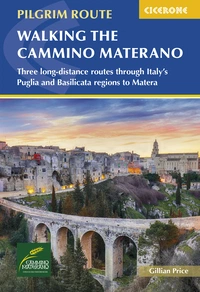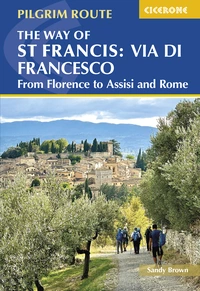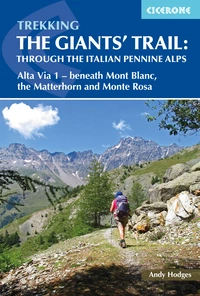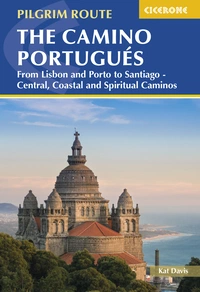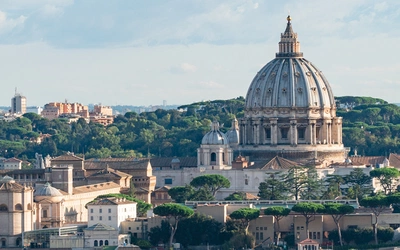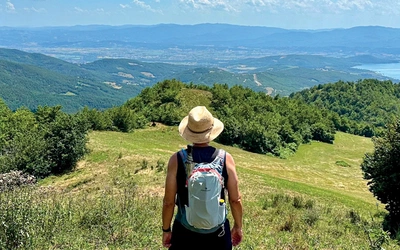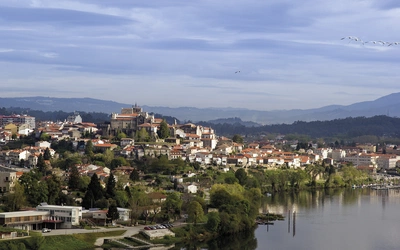An introduction to the Cammino Materano
The Cammino Materano (CM) is a distinctive walking experience across two little-known regions of southern Italy — Puglia and Basilicata — comprising three long-distance routes that converge on the remarkable UNESCO World Heritage city of Matera. Created as a community-led project to promote sustainable tourism and local employment, the CM offers walkers a blend of vast coastal plains, rolling wheatfields, olive groves, woodland, and dramatic limestone ravines, threaded with ancient villages and historic towns. With routes ranging from six to fourteen days, you can explore one, two, or all three, taking in landscapes, culture, and local hospitality at a relaxed pace. Here's what you need to know.
Walking the Cammino Materano
Three long-distance routes through Italy's Puglia and Basilicata regions to Matera
£18.95
Guidebook to walking three long-distance routes along the Cammino Materano in Puglia and Basilicata in southern Italy. The 7-day Via Peuceta (168km) from Bari, 14-day Via Ellenica (287km) from Brindisi and 6-day Via Lucana (115km) from Tricarico all finish in the ancient cave city of Matera. Includes information on preparation, planning and accommodation.
More information

What is the Cammino Materano, and why do walkers choose it?
The Cammino Materano is a network of long-distance pilgrimage and cultural walking routes across southern Italy, all converging on the extraordinary city of Matera. Unlike some of Italy’s better-known northern trails, this is a journey through quieter landscapes and deeply authentic communities: olive groves stretching to the horizon, whitewashed hilltowns, cave-studded ravines and villages where traditional life still shapes the rhythm of each day. Walkers choose it for its sense of discovery and a slower, more intimate experience of Puglia and Basilicata.
Where do the routes start and finish?
Three main routes form the CM:
- Via Peuceta (VP): begins at Bari, the historic Adriatic port.
- Via Ellenica (VE): starts from Brindisi, another strategic harbour city.
- Via Lucana (VL): originates in Tricarico, in inland Basilicata.
All three converge in Matera, renowned for its Sassi cave dwellings and dramatic ravine setting.
How long are the routes, and what distinguishes each one?
Each route varies in scenery and character, allowing walkers to choose according to time, stamina, and interests:
- Via Peuceta: 7 stages, 167.5 km (~7 days). Traverses olive groves, wheat fields, and woodland across a steppe-like plateau. Highlights include Bitetto Cathedral, Altamura’s archaeological museum, Gravina di Puglia with its ravine and underground dwellings, finishing in Matera.
- Via Ellenica: 14 stages, 287.6 km (~14 days). From Brindisi through the Valle d’Itria and the land of trulli, visiting Ostuni, Cisternino, Alberobello, Laterza and Ginosa gravine, and towns like Martina Franca and Massafra before Matera.
- Via Lucana: 6 stages, 114.6 km (~6 days). Hilly terrain through Basilicata, connecting old villages perched on ridges, with historic watchtowers and Roman-era connections via the Via Appia.
How do I get to the start and end points of the Cammino Materano?
Both Bari (for the Via Peuceta) and Brindisi (for the Via Ellenica) are easily accessible from across Europe by plane, train, or long-distance bus. Brindisi is also served by ferries from Greece, and seasonal flights from the USA land at both airports. Onward transport is available to Matera and other points for the Via Lucana.
Returning from Matera is straightforward by train or bus, with connections to Bari, Brindisi, and other Italian cities. Most towns and villages along the routes have public transport, and Flixbus offers direct services from Matera to Bari airport. FAL trains, with a change at Altamura, connect Matera to Bari for onward Trenitalia connections.
What kind of terrain and walking conditions should walkers expect?
Walking is on mixed countryside paths: quiet farm lanes, narrow rocky trails, stony tracks, and some steeper ascents and descents. VP and VE are flatter near the coast, rising inland; VL is hillier with more significant height gain and loss.
Is it difficult, and who is it suitable for?
Difficulty ranges from easyto moderately hard. Fit walkers covering 15–30 km per day will find the routes manageable. The CM is suitable for solo walkers, couples, and small groups, with many visitors walking alone. The credential and community support provide reassurance and structure for independent walkers.
When is the best time of year to walk?
Spring (March–May) and autumn (September–October) are generally ideal, offering moderate temperatures and enjoyable walking conditions. Summer can exceed 30 °C with little shade, so early starts and midday rests are advised. Winter brings shorter days and occasional wet weather but can still offer excellent walking conditions.
What kinds of landscapes and scenery does it pass through?
The CM traverses diverse landscapes: low-lying coastal plains planted with olives and grapevines, wheatfields turning golden in late summer, Mediterranean oak and pine woodland, and dramatic limestone ravines (gravine) dotted with cave dwellings. Villages and historic towns punctuate the routes, providing a continual sense of human presence amid vast open spaces.
What cultural and historic highlights are there along the way?
Walkers encounter towns with rich local traditions, crafts, and architecture. Laterza is known for its majolica ceramics, while Miglionico boasts a medieval castle. Alberobello is famous for its conical trulli houses, and Ostuni charms visitors as a whitewashed hilltop town. Altamura is renowned for its bread ovens, and Gravina is notable for its aqueduct bridge. The region’s cuisine is equally distinctive, with fresh breads, orecchiette, cavatelli, panzerotti, peperoni cruschi, lampascioni, cheeses, and figs. Local wines such as Primitivo di Manduria, Aglianico delle Vulture, and Malvasia Bianca complement the food. Pilgrim menus, typically costing €15–20, are available at some restaurants, often with discounts for credential holders.
What is accommodation like and how easy is planning?
Accommodation includes CM-affiliated B&Bs, hostels, and small hotels, usually costing €25–35 per night. Some offer kitchen facilities, while others provide breakfast. Booking via the CM website is recommended, with booking.com or other agencies as a fallback. CM staff can assist with bookings for a small fee. Lodgings are generally welcoming and comfortable, allowing walkers to experience the region authentically.
Do walkers need special preparation or equipment?
No specialist equipment is required beyond normal multi-day walking gear: comfortable shoes, rucksack, sun protection, and water. Each walker must obtain the CM credential, available online or at the route start, which allows collecting stamps at villages and redeeming the testimonium in Matera as proof of completion. A small donation (€5 minimum) is requested to cover costs and postage.

